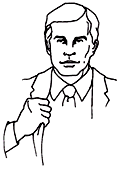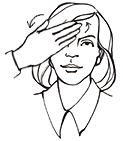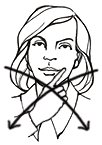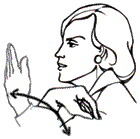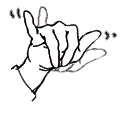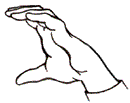All futures contracts have an expiration month; thus, there are standard hand signals that indicate each month.
Hand Signals for Futures Contracts Months
Expiration cycles
Trading Eurodollars involves a set of hand signals that convey expiration cycles. Eurodollars are listed in quarterly cycles, extending out 10 years. They are traded in 12-month “packs”, consisting of four 3-month quarters, with expiration months of March, June, September and December. Each 12-month pack is assigned a certain color. For example, the first series of contracts – those that are up to one year out – are called the “whites”, although they’re usually just referred to as the “front months”. After “the whites” come the “reds”, (the series of contracts one to two years out), followed by the “greens” (which are two to three years out), and so on. (The colors for the years four through 10 are, respectively: blue, gold, purple, orange, pink, silver and copper.) There is a hand signal that indicates each of these packs, except for the whites or front months. You can see the signals for some of these below.
Market Signals
Other hand signals convey the following:

Filled
Thumb up; indicates that an order is completely filled.
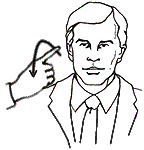
Working
Index finger rotates forward; means that the broker has not filled the order but is still attempting to do so; also used for partially filled orders on which the broker is still working to fill completely.
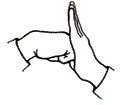
Stop
Fist into palm; means that the order is a stop order (activated when the price reaches a certain level).
At that point, a stop order becomes a market order and the broker must attempt to get the best price when filling it. Can be used to enter or exit both long and short positions. For example, if you are long and fear a drastic price drop, you can issue a stop order to be activated when the contract drops to a given price. Your stop then becomes a market order that the broker will attempt to fill before the price drops even more – even if it requires selling at or below the stop price. Likewise, a short can issue a “buy” stop order if he fears the price will rise.

Out/Cancel
Hand moves across throat; shows that the order has been canceled.
Options
In options trading on the CME floor, traders need to indicate whether an order is a put or a call, in addition to using the standard signals to convey other information about the order.
Put
|
Call
|
Summary
This has been a brief introduction to CME’s hand signals. Anyone who works on the Exchange floors needs to know and use these signals perfectly. Hand signals are essential for successful pit trading at CME, and using the wrong signal could result in a substantial loss.
“An Introduction to Hand Signals” is published by Chicago Mercantile Exchange for general educational purposes only. Although every attempt has been made to ensure the accuracy of the information contained here in, CME assumes no responsibility for any errors or omissions. All matters pertaining to rules and specifications herein are made subject to and are superseded by official CME rules.
This material is published by Chicago Mercantile Exchange’s Education Department for the purpose of educating exchange members, floor clerks, employees and students. Reproduction for any purpose without the written permission of the Education Department is strictly prohibited.
Contents Courtesy of CME Group.




